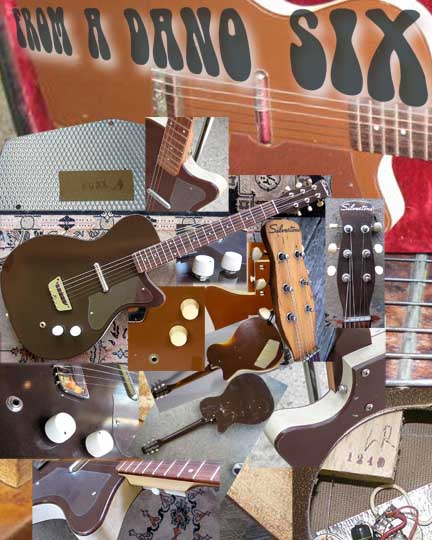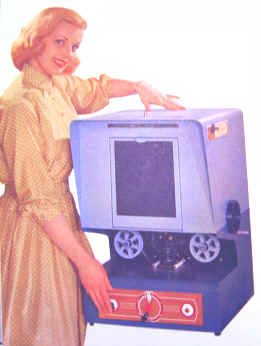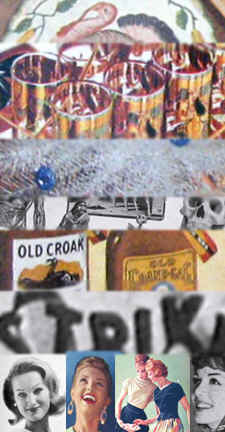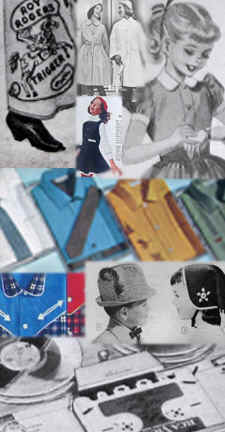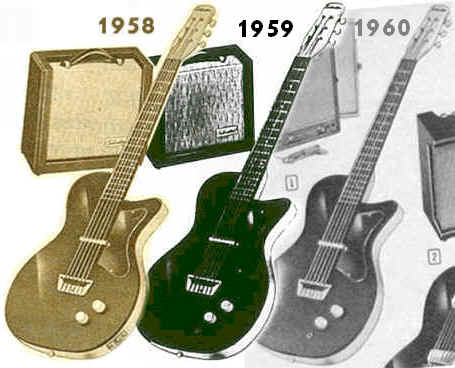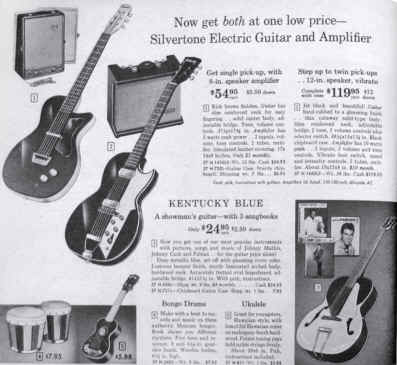|
|
I've been wondering about this guitar since the first time I saw it. Even now, with every scrap of comforting ephemera I can find on this odd changeling of a guitar to read and investigate, it seems I get further away. The guitar in question was made by Danelectro, branded a Silvertone and sold by Sears. I've seen it in a plain brown finish. I've seen it with gold glitter in the brown finish. I've seen the headstock with a maroon ink on a natural-finished headstock, I've seen the headstock decorated with a silver-white logo on brown, I've seen silver on natural. I've seen the straight-neck-joint with a circular panel and a swoop neck with a five sided aluminum access panel, and I've seen a couple that mix and match all these characteristics (and more) that I take into account when I try to determine what kind of guitar I've got in front of me. If I had access to the neck pocket or circuitry cavity of every one of these I see, I could categorize them by year. But as it is, these guitars were offered in the Sears & Roebuck 'Wish Book' catalog and Christmas-related advertising of 1958, 1959 and 1960. They were identified by a different number each time, and offered each time paired with a different amplifier. Here's the story of how I found all that out, and somewhere in there, why I care. | |
| When I first encountered this guitar in ebay auctions 15 years ago, I puzzled at its provenance. Its odd, mid-placed pickup did not match known (catalog-listed) configurations for the type of body this guitar was. So, when I'd see the guitar, I'd save the picture in a folder called "Brown Dano." Then, in early March 2008 I received an email that proclaimed "I've solved the mystery!" and contained the address to a website called WishBookWeb. The site contained scans of a multitude of Sears and Penney's and Monkey Wards (and a few Spiegel and other lesser players) Christmas catalogs. But I paged through the 1958 Sears Wish Book quickly to get to the nugget of info I knew was there: on page 231 was the mid-pickup'd mystery guitar, and now it had a name! The catalog numbers told you you could get the guitar all by itself by ordering the 1304 from the Wish Book. There was an accompanying offer that included an amp, as well, and I'm sure the buyers at Sears knew they could move a lot of units if they had a nice pairing of an amp and guitar for a low price. 1304! Yay! |
 |
|
|
|
There things sat, with the odd
guitar being called the 1304, and all was happy in Silvertone World.
Fast forward to June 2010, and a research trip to Duke University. Their
wonderful library has the entire Sears catalog collection on reels of
microfilm from the late 1800s on through the early 1970s... a murky,
sometimes indecipherable, but mostly chock full of model availability
information, vintage catalog art and its florid language descriptions,
strange products and an odd everyday look a look at an America gone by.
Those microform records have been invaluable in tracking down the model
numbers and periods of availability of Silvertone-branded guitars, amps
and other products from the 1930s through the 1970s, and I had a few
holes to fill in my collection. I especially wanted to examine all I
could find of the late 50s and early 60s Wish Books, as the 1304 guitar,
I had come to believe, was offered in the 1959 and 1960 Wish Book
catalogs as well, as I frequently saw guitars with subtle but clear
differences among
them, pointing to later build dates than 1958. These differences included
(of course) serial numbers, but also headstock color, finish, and on the back side of the
guitar what kind of circuitry access panel was there and the type of
cutout available for the neck to fit in. I found Wish Book microfilm
reels for 1959 and 1961, but nothing from 1960. So, with my photocopies
in hand, I try to cipher out the new info as it applies to our beloved
brown guitar. |
 |
| After a bit of squinting, I had a new number for the 1959 version of this guitar, the 1450. The smallish 1451 was the amplifier paired with this model and was available for this catalog only, 1452 being the model designation of the pair sold together. On the same research trip, I found another 1450 guitar hidden in the catalogs; Sears recycled the part number for a another Dano-built guitar for 1965. This tortoise-pickguarded 1450 was the direct predecessor of the white pickguarded 1452 that was to take over the upper-end "amp in case" duties from the venerable 1457 in Spring/Summer, 1966... yup, it's another Wish Book-only model! This was a solid-body guitar built as Dano's days as a supplier to Sears were numbered. After the sale of the pioneering company to conglomerate MCA in 1968, it was all but over for our favorite guitar concern from Neptune, NJ. Nevertheless, I now had another number sharing the new number, and more puzzles. I also came across the 1961 Wish Book guitar pages for that year and solved a mystery that had been plaguing me nearly as long as the 1304. This guitar (a mysterious Kay, I finally determined) appeared in the 1961 Sears Wish Book paired with an odd bird: an organ amp on legs. Maybe amp organs hadn't sold so well that year, and the deal was to 'blowout' the remaining 4707 model amps. So there you have another discovery, the interestingly pickguarded Kay-made cousin of its "Value Leader" model (a rarity in today's market), the Silvertone 1412L2 paired with the leggy 4707 as that years' Yule Deal, and together the couple was known as catalog number 1458. |  |
|
| Now, we have the question of 1960. I
knew some of the 1304 guitars had been sold in 1960, because examples I
would come across bore the sure signs of a 1960 produced Danelectro
guitar: The five-sided corrugated aluminum panel for access to the
guitar's circuitry, and the 'swoop' neck cutout; a more graceful cut to
the back of the guitar where the neck and body come together and the
guitarist reaches the higher-pitched locations on the fretboard of this
guitar. So, 1960 became my quest: I needed a Wish Book catalog
from what I felt was a crucial year. So, as I'm usually pokin' around
there anyway, I turned to ebay, searching through the expensive Sears
catalog auctions, hoping for a break. I got one. |
 |
|
|
|
My long-awaited info arrived yesterday, in the form of a DVD with the entire 1960 Sears Christmas Wish Book scanned into a large PDF file for my perusal. Twenty bucks was a relatively low price to pay, given the high prices that vintage Sears Wish Books command on the popular auction site. I loaded the file up (after testing a couple of non-Adobe PDF readers, I found one that rendered the file reasonably and in a format that I liked), and began paging through Christmas 1960, the same pages your average American would have been perusing, the same pages kids across the country would be making lists from, the same pages Santa shopped from that year, an now-computerized echo of color lithography from the America of 1960 - the time of the Mad Men and the Space Age, heroes and scoundrels... a time much like today, except that it was very different. Party sets! T'ang Dynasty! Wheat plates! Decorations! Rooftop Santas! Aluminum trees! Wiffsky Spoofs! Bowling towels! Slippers! Shoes!
Boots! Electric manicure machines! Mirrors! Hair
Dryers! Old Spice! Timex! |
 |
|
|
As I pass through the strange-but-familiar
little girls and little boys fashions ("the 'new' look is TYROLEAN!"), some featuring a popular cartoon
character or movie character of the day, I start to get impatient,
wondering when I'll get to my one precious guitar page, with the
Definite Last Word on the Fate and Appreciation of the 1304/1450 Guitar
Series. So, on I go, through brightly colored bedspreads, rugs, floor
coverings, drapes and aprons. Then, right after some cedar chests and
the odd ottoman, a TV appeared! As Sears tended to bunch entertainment
electronics together, I reckoned my guitar would be popping up on my
screen soon, so I slowed down. Two reasons; being nerdly enough to care about and track down the esoteric information of a
guitar's model number and years of availability, I am also drawn to the TVs, record players,
transistor radios and other devices available in these pages. And, two, I don't
want to know just a little bit longer... so I can savor the revelation
of my hard-fought long-sought model number.
|
|
|
|
Back to the guitar listing. Aside from one structural detail, it seems to be the exact same illustration that has been used since the availability of this guitar began in 1958. It's that one little detail that I'm sure made the Sears layout folk do a quick face-palm when the 1959 illustration for the guitar came along. Closer inspection reveals that the 1959 and 1960 model illustration didn't show a side-mounted jack, but rather a top mounted jack; a production cost-cutting measure by Danelectro. One little change and they were gonna have to go through modifying the artwork, exposing a photographic plate, developing it, printing it, trimming the film or print with a blade, enlarging or reducing your pieces to fit on the primitive (but state of the art at the time) typesetting/publishing equipment at hand. Sears catalog layout folks didn't have access to the same stuff me and you do as far as making our will known over the printed/transmitted page like we do here in 2011. No sirree! None of this take a digital shot that Eye-Fis over to your server, pour that pic into Photoshop, magic wand select just the guitar from the background (or be artsy and leave it in, all cloudy and mysterious and what-not) and then get your pic centered oh so easily in your layout program and hit Print and Voila! a full picture of what folks will be looking at when they rip the brown wrapper from the catalog in a matter of seconds rather than days. They couldn't do all that in less time than it takes to read about it it, but change it to reflect the product they did... mostly. Despite the fact that I see more of the brown-headstock'd version of this guitar as opposed to the plain-finished version, only the natural-finished head with a maroon cursive Silvertone logo was ever illustrated. A quick comparison of the 1958, 1959 and 1960 illustrations confirms them to be the same artwork, thanks to some unique highlights to the representation of the surface of the guitar, and the '59 and '60 versions just had that one little tweak. Seems the 1958 usage of the side-mount jack illustration was an error, anyway; I've never seen a 1304-series guitar with a side-mounted jack. | |
|
|
So, there it lies. A mishmash of info that I feel compelled to add some order to or impose my (what passes for) reasoning upon. So, here goes. Henceforth at SilvertoneWorld and its affiliates, this guitar will be known as the 1304. It's a unique Sears catalog number (never duplicated...the model number 1450 used in 1959 is duplicated a few years down the line in another Dano-made guitar, and the 1456 is a weird stock-moving combo-only number that I'd feel bad using as a number designation in the best of circumstances, and this model number was also recycled in a few years on a Teisco hollowbody). 1304 was applied to this guitar alone at its introduction in 1958. In references in auction recaps and general identification conversation, I'll call this guitar the 1304, and not quibble. So... 1304. 1304. 1304. It's a cool number, too. Rolls off the tongue easily. Try it. Thirteen Oh Four. Thirrrrteeeeen Oooooooohhhhh Fooooouurrrrr... There ya go. See? It's already got some traction! |
|
|
|
||
|
|
||
